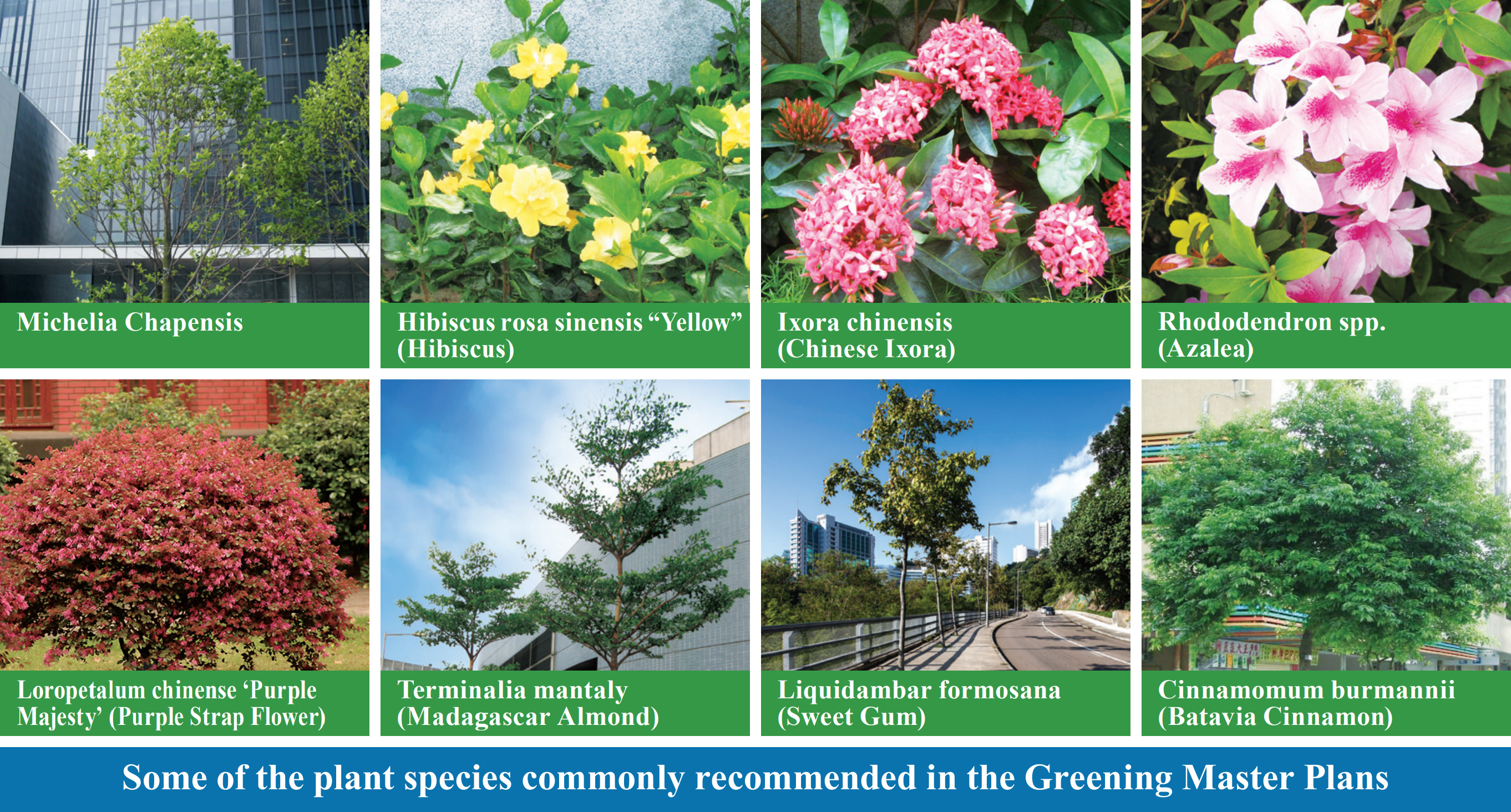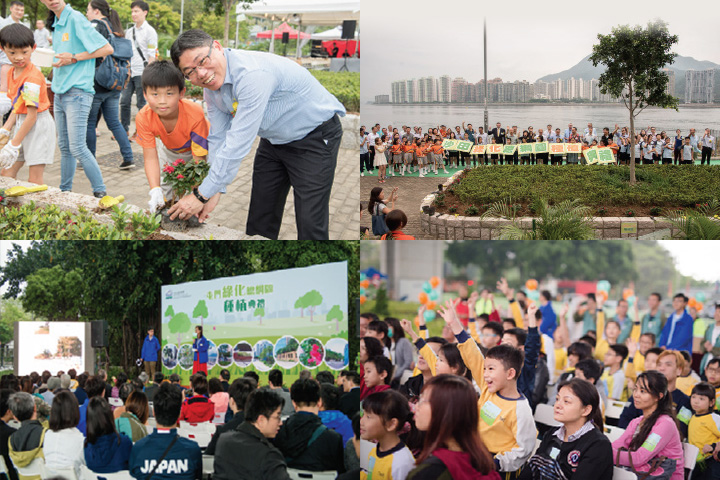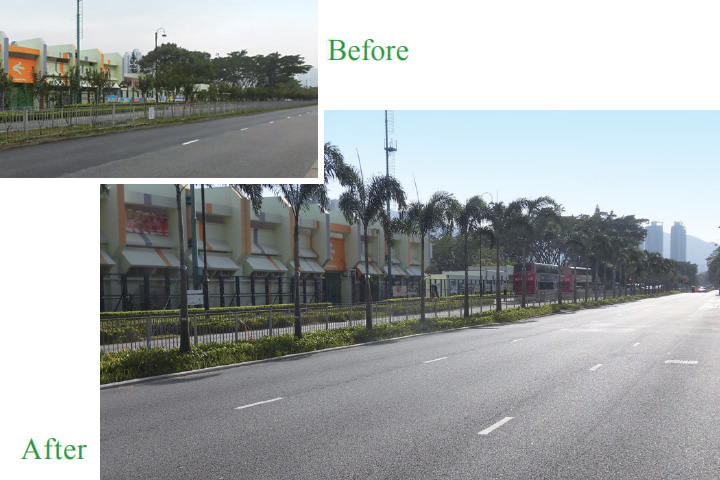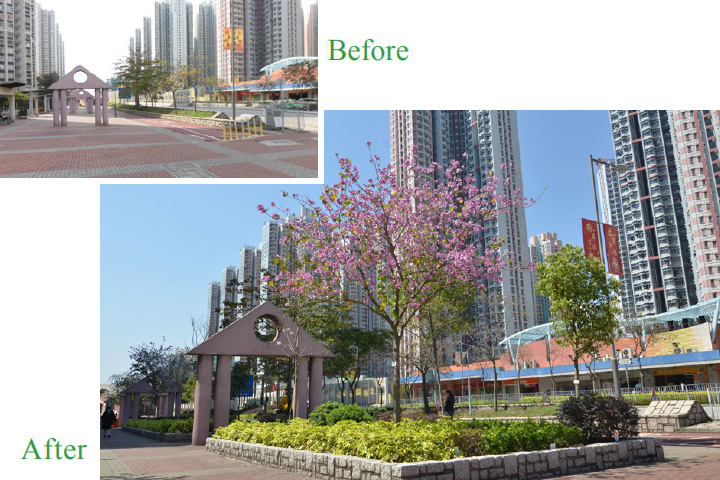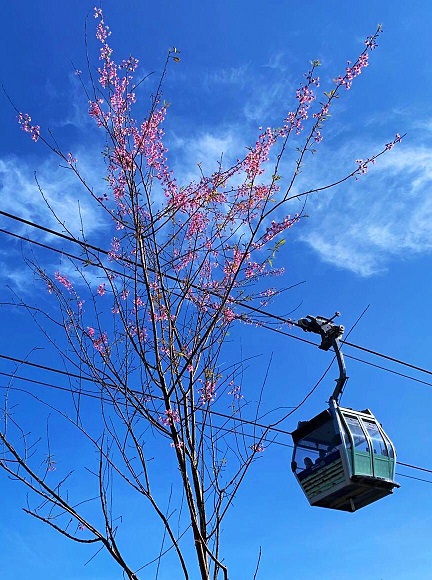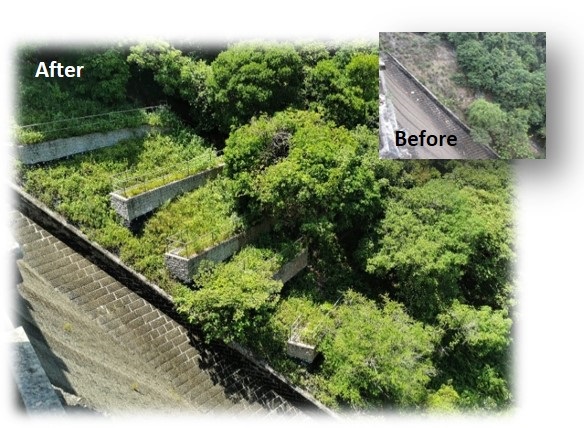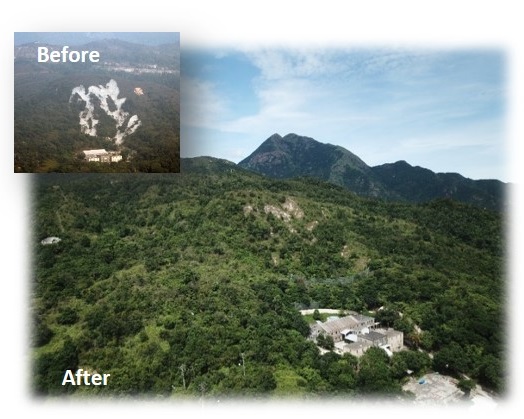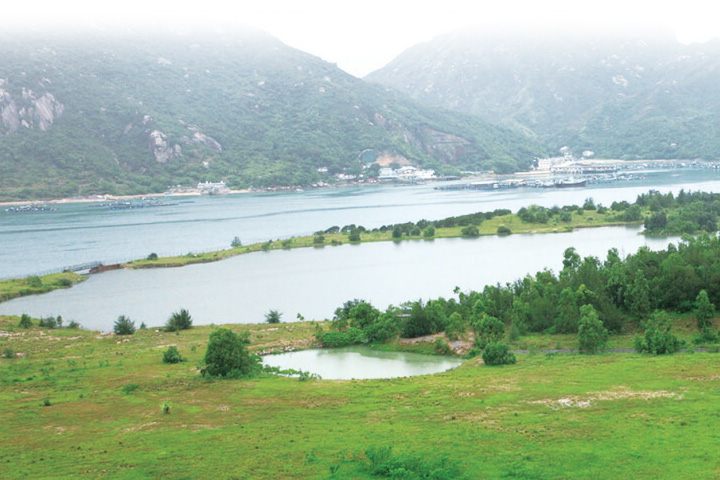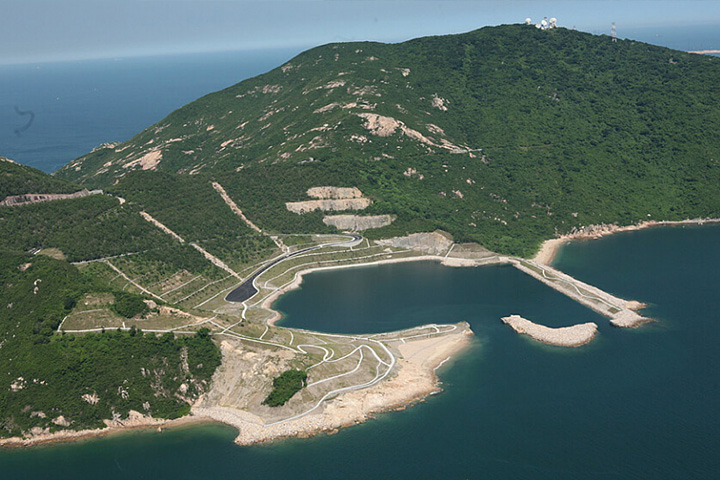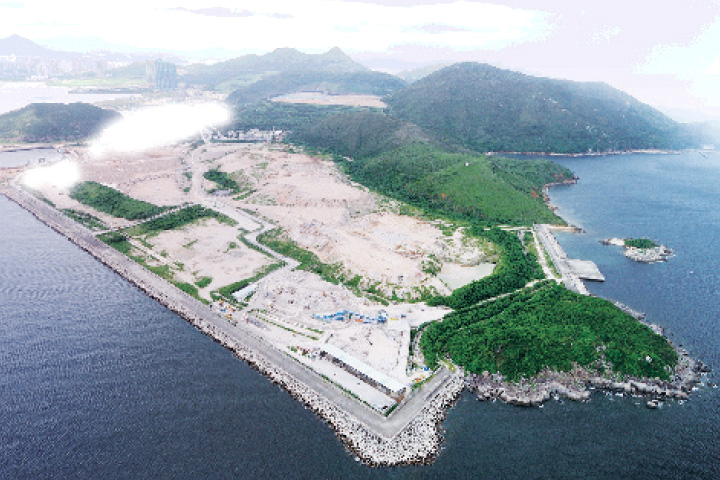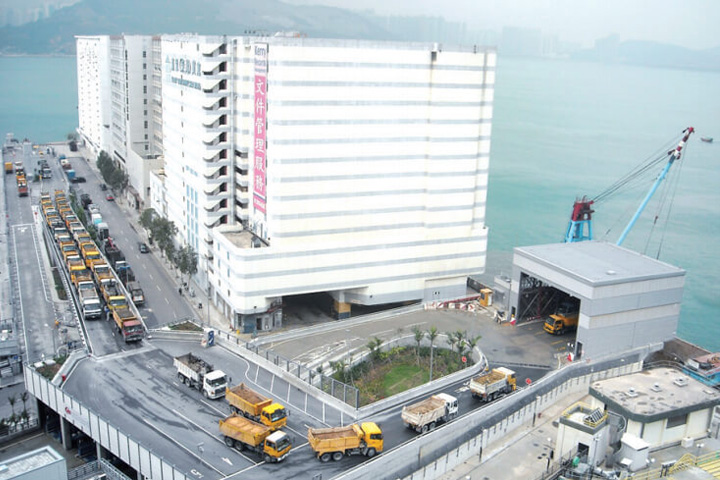Greening
Greening works contribute to the improvement of air quality in addition to the aesthetic of an area. They are essential to the protection, rehabilitation and enhancement of our landscape and ecological environment, which helps create sustainable environmental outcomes. Apart from fulfilling the functional requirements of the development projects, the Civil Engineering and Development Department (CEDD) has been actively promoting greening through a wide range of initiatives, including (1) development and implementation of the Greening Master Plans (GMPs) and other greening initiatives; (2) greening works associated with infrastructure projects; (3) greening works associated with the Landslip Prevention and Mitigation works; (4) greening works for quarry rehabilitation; (5) soil erosion control planting on natural hill slopes; and (6) tree risk assessment and management.
Some of the plant species commonly recommended in the Greening Master Plans
Development and Implementation of Greening Master Plans and Other Greening Initiatives
A Greening Master Plan (GMP) seeks to define comprehensively the greening framework of an area by studying its characteristics and particular needs, and providing a guide to the planning, design and implementation of greening works. To ensure high-level commitment to the GMPs, each GMP is approved by the Greening Master Plan Committee chaired by the Director of Civil Engineering and Development, and endorsed by the Steering Committee on Greening, Landscape and Tree Management chaired by the Permanent Secretary for Development (Works).
We promote public participation in the GMP formulation process and adopt the "Enhanced Partnering Approach" whereby each relevant District Council forms a District Participation Group (DPG) to partner with us in reviewing the contents of the GMPs and to advise us on the greening of the districts. The successful implementation of greening measures is made through expertise and coordination of multiple disciplines, including landscape architecture, town planning, civil and traffic engineering and even public relations. We organise community planting ceremonies and school talks and invite local residents to participate in our planting activities. We believe that public participation not only enables us to tap into valuable local knowledge but also creates a sense of ownership of the GMPs in the community. We have received very encouraging responses and appreciation of our works from the public.
Following the successful completion in 2011 of the GMPs for the urban areas, we commenced the greening works in the GMPs for Sha Tin, Sai Kung, Tuen Mun and Yuen Long in 2014, and completed them in 2017. We have planted about 4,000 trees and 2.6 million shrubs in the four aforementioned districts. We are implementing GMPs for New Territories in Tsuen Wan, Kwai Tsing, Islands, Tai Po and North District.
Here are photos of some of the completed greening works in urban areas and the New Territories:
Landscape Improvement Works in Ngong Ping
The Sustainable Lantau Blueprint announced in June 2017 by the Government dedicated part of Lantau Island to be used for conservation with sustainable leisure and recreational purposes. In view of the cool climate, good transport connectivity as well as the synergy with the existing tourist attractions in Ngong Ping, we have planted around 400 cherry trees and native spring-flowering trees in Ngong Ping for visitors' enjoyment during the blossoming season.
We commenced the landscape improvement works in Ngong Ping in January 2018 and completed the planting works in Q3 2018. Establishment works for the newly planted trees are now in progress.
Greening Works Associated with Infrastructure Projects
To fulfill the community's growing need for well-being and quality of living, most of our infrastructure projects include the provision of planting schemes serving as landscape/ ecological enhancement and impact mitigation measures. Such greening works involve planting in a variety of settings like roadsides, footbridges and flyovers, podiums, slopes, river channels and promenades.
In our major infrastructure projects with planting schemes (including Heung Yuen Wai Highway, Kai Tak Development and Central-Wan Chai Bypass, etc.), approximately 460,000 plants were planted in 2018.
Greening Works Associated with Landslip Prevention and Mitigation Works
Sustainable Slope Excellence Award
Year 2020 marked the 10th Anniversary of the LPMitP, we specially held the Sustainable Slope Excellence Award to recognise the contribution of the engineering sector in improving slope safety while maintaining the sustainability of the natural ecology. The Award is divided into two categories, namely Man-made Slope/Retaining Wall Category and Natural Terrain Category.The award-winning project of the Man-made Slope/Retaining Wall Category has adopted the concept of terraced planter walls to stabilise the slope. Apart from installation of soil nails to reinforce the slope at its toe, pit-by-pit excavation with backfilling of concrete was carried out from the middle to the top of the slope. Such slope stabilisation method could provide space for planting and enhance the biodiversity of the slope at the same time. The slope is right next to the dam of Kowloon Byewash Reservoir, a Grade 2 Historic Building with a history of 90 years, adopting the method of terraced planter walls could minimise the impact on the dam during construction. Besides, the planter walls and adjacent areas are paved with masonry blocks to integrate the slope with the dam in their appearance.
The award-winning project of the Natural Terrain Category has adopted soil bioengineering measures to design and improve the appearance of the natural hillside. Due to emergency slope stabilisation works conducted after a number of landslides at the natural slope of Upper Keung Shan in West Lantau, shotcrete scars of about 4 500 square metres were left in the natural terrain. Therefore, the project team had to remove the shotcrete scars on the terrain first and then adopt various measures to mitigate the risk of landslide according to the geological conditions of the slope. The use of soil bioengineering is not simply growing plants, but also about assessing biodiversity, and it is self-sustaining, natural and aesthetically unobtrusive terrain management approach. Besides, the works project has innovative sustainable features, such as upcycling the broken-up shotcrete surface to integrate it with rock drains to avoid the generation of construction and demolition materials.
Greening Works for Quarry Rehabilitation
The plan to rehabilitate quarries was formulated in 1989 as an outcome of the Metroplan Landscape Strategy for Urban Fringe and Coastal Areas, which identified quarries as areas of degraded landscape requiring rehabilitation. The rehabilitation works typically involve major recontouring and extensive planting. Upon completion of the quarry rehabilitation works, attractive greened areas will be formed for a variety of uses beneficial to the community.
Under an innovative scheme developed by the Government and the quarrying industry, we completed the rehabilitation works at Lamma Quarry in end 2002, Shek O Quarry in early 2011 and Anderson Road Quarry in mid 2017 and are managing the existing quarry rehabilitation contract at Lam Tei. In the course of quarry rehabilitation, slopes are revegetated extensively with suitable vegetation with a long-term objective of creating anticipated climax vegetation communities that will blend ecologically and aesthetically with the surrounding natural vegetation and providing favourable habitats for wildlife. In 2017, we planted about 800 plants in connection with our quarry rehabilitation projects.
Soil Erosion Control Planting on Natural Hill Slopes
Under the soil erosion control planting programme on natural hill slopes, we primarily establish vegetation covers on the eroded or erosion-prone slopes on unleased or unallocated land outside country park. The objectives are to control soil erosion and enhance the ecological and landscape value of the degraded land. From 2016 to 2019, we planted about 90,000 number of plants in Tuen Mun Trail, Lam Tin Black Hill and Shui Chuen O.
In the planting schemes, we adopt a mixture of plant species, which includes native species to promote vegetation diversity and pioneer species to arrest any further soil erosion. We also continue to exchange knowledge and experience with other government departments to further enhance our effective greening works for different soil erosion situations.
Tree Risk Assessment and Management
To ensure public safety and for sustainable development and tree care, we conducted an annual tree risk assessment and management exercise for approximately 30,000 trees located in a variety of works sites in early 2019 prior to onset of the rainy season, according to the guidelines promulgated by the Greening, Landscape and Tree Management Section of the Development Bureau. The tasks include conduction of tree inspections, tree risk assessments, appropriate mitigation tree works and the related tree audits.
Management of Construction Waste
The composition of construction waste varies, depending on the nature of the construction works. In general, about 90% of it is inert construction materials, also known as public fill, which is suitable for reuse in reclamation and earth filling works, or recycle for use in other construction works. The remaining non-inert construction waste, subject to recovery of reusable/ recyclable items, is disposed of in landfills.
In 2023, our local construction activities generated about 16.1 million tonnes of public fill, 5.2 million tonnes of which were reused and the remaining 10.9 million tonnes were stockpiled temporarily in the fill banks for reuse in the future. As at December 2023, we stockpiled about 22.6 million tonnes of public fill in the 2 temporary fill banks located in Tseung Kwan O Area 137 and Tuen Mun Area 38.
In managing this huge volume of construction waste, our objective is to promote the reduction, reuse and recycling of public fill and to prevent public fill from being disposed of in landfills, which are designed primarily for putrescible waste. Specific measures include:
- Avoiding and minimising construction waste generation at sources through better planning, design and construction management
- Implementing Construction Waste Disposal Charging Scheme to provide an economic incentive for waste producers to reduce construction waste that requires disposal
- Processing/recycling public fill
- Setting up sorting facilities to facilitate the reuse of inert materials
- Establishing temporary fill banks to stockpile surplus public fill temporarily to facilitate later reuse
- Setting up barging facilities for collection of surplus public fill and delivery to the fill banks
- Reusing surplus public fill in Mainland/local reclamation projects
To ensure proper disposal of public fill arising from local construction activities, we are operating the temporary fill banks and construction waste sorting facilities at Tseung Kwan O and Tuen Mun and the barging facilities at Chai Wan and Mui Wo.
Reuse of Surplus Public Fill in the Mainland
Since the reclamation projects in Hong Kong are unable to absorb all the public fill generated by local construction, excavation, renovation, demolition and road works, we are currently relying on two fill banks for temporary storage of public fill. Notwithstanding different management measures taken to reduce fill generation at source and to promote its reuse and recycling, we still face the problem of surplus public fill.
To tackle the problem, we continue to explore opportunities to reuse our surplus public fill in Mainland. The Government signed a Cooperation Agreement with the former State Oceanic Administration (SOA) in March 2004. It provides a foundation for delivery of our public fill in Mainland waters. We further reached an agreement with the former South China Sea Branch of the State Oceanic Administration (SOA(SCSB)) in June 2005 on the implementation details, including the material specifications, delivery requirements, inspection and control measures, to ensure that the use of public fill in the Mainland's reclamation projects will not cause any environmental problems.
In January 2006, the former SOA(SCSB) designated a trial reclamation site in Guang Hoi Wan (廣海灣) of Taishan (台山) to receive public fill from Hong Kong. Contracts were subsequently awarded for the cross-boundary delivery of surplus public fill to the reclamation site concerned. In October 2023, the Government and the Ministry of Ecology and Environment signed the updated Cooperation Arrangement on Management of Cross-boundary Dumping. Premised on the existing management principles, the Cooperation Arrangement updates the details of the arrangement and reflects the changes in the government structure of both sides in recent years. The delivery of public fill to Taishan commenced in July 2007 and about 138 million tonnes of public fill have been delivered up to December 2023.
The scheme demonstrates that the delivery of surplus public fill to the Mainland for reuse is an environmentally sound and mutually beneficial arrangement. This arrangement helps alleviate our pressure in accommodating surplus public fill and enables beneficial reuse of our public fill in the Mainland. In the absence of the scheme, the fill banks would have already been filled up and any surplus public fill would have to be disposed of in landfills, of which the capacity is fast depleting.
Conservation Work
Upholding firmly the planning principle of "Development in the North, Conservation for the South", we will carry out infrastructure and development projects along the direction of "Conservation to Precede Development".
We endeavour to take forward various initiatives to enhance conservation while promoting leisure and recreation proposals that are sustainable and compatible with the local context of Lantau. We have formulated the Lantau Conservation and Recreation Masterplan to provide a framework guiding our conservation and recreation initiatives. We set up a $1 billion Lantau Conservation Fund in 2020 to support conservation and related projects. We also take forward the public engagement, education and promotion activities in our studies and projects to enhance public awareness of conservation and promote sustainable development of Lantau.
We strive to promote sustainable leisure and recreation activities in Lantau for public enjoyment. We have formulated the Lantau Trails and Recreation Plan and will take forward this visionary plan in phases for the development of a hiking trail network connecting as many heritage, ecological and recreational hotspots as possible, provision of diverse leisure experience and promotion of healthy living.
